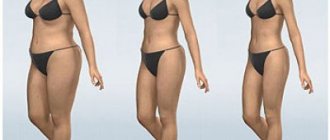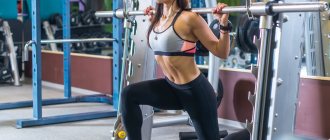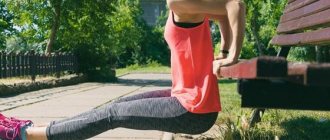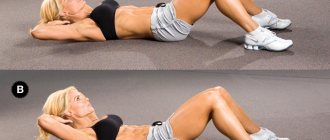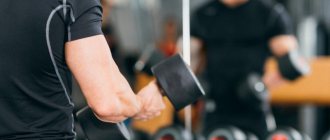Do you want to round your butt, improve the shape of your calves, or build up your pectoral muscles? Do you dream of making your stomach flat and your arms elastic? The secret to achieving these goals is a properly designed training program. You can be sure that regular training according to a properly designed program will lead you to progress.
The Lifehacker Telegram channel contains only the best texts about technology, relationships, sports, cinema and much more. Subscribe!
Our Pinterest contains only the best texts about relationships, sports, cinema, health and much more. Subscribe!
Increasing strength without mass
There are people whose mass grows quite quickly, but their strength does not increase. So, there is a program for training in a gym to gain strength without mass. Let's ungroup the types of exercises for three days. We work the back muscles separately in one day. On the second day, you need to do exercises for your arms and trapezius. On the third day - to all other muscle groups.
As practice has shown, this is the most effective training, but it is worth considering that you need to do only basic exercises first, and then move on to complex ones. Don't forget to warm up before each workout.
VII. Determine the number of sets and reps
A very important parameter. After all, it directly affects the intensity of your workouts. The heavier the weight and the lower the number of repetitions, the lower the training intensity and the less energy you expend. I usually distribute approaches (including warm-up) and repetitions like this:
When gaining mass – 3 – 5 sets of 6 – 12 repetitions in basic exercises. And 3 - 4 sets of 10 - 15 repetitions in auxiliary exercises.
When increasing strength - 4 - 5 sets of 2 - 6 repetitions in basic exercises. And 3 sets of 8 - 12 repetitions in auxiliary exercises.
Weight loss – 2 – 4 sets of 12 – 20 repetitions everywhere.
Relief – 2 – 4 sets of 12 – 15 repetitions everywhere.
Maintaining the achieved form – 3 – 4 approaches. The number of repetitions depends on your previous goal.
Duration of training: how much time to spend on approaches
Training is a great stress for the body, so the duration of one lesson should be on average 1 hour. When overloaded, the body begins to produce cortisol, a hormone that destroys muscles, and other catabolic and other substances are also released. If a workout lasts more than one hour, muscle recovery processes slow down several times.
Between approaches in the training process it is necessary to rest. Its duration is 1-1.5 minutes. This mode makes classes much more effective. When drawing up a schedule and training program, it is advisable to focus on the following numbers:
- Approach – 30 seconds.
- Rest/recovery – 60-90 seconds.
Interesting fact. If you train in this mode, you can cram about 30-40 approaches to various exercises into a lesson. This is the maximum possible limit. In practice, a smaller amount is sufficient.
Training frequency
How often do you need to train to achieve results - what schedule will be optimal? There are several points to consider:
- The actual state of the muscles. All muscle groups are divided into large and small. The former take a significant amount of time to recover due to their size - requiring an average of one to two days of rest than the latter.
- Training. This is a controversial point, since with active physical activity the muscles adapt faster. However, with regular training, the muscles become larger, which means it requires significant recovery time.
- Standard load volume. The longer and more actively a person trains, the more time it takes to recover.
Professional trainers take these points into account - periods of rest and active training. In this case, beginners are recommended to train with a frequency of one visit to the gym and 2-3 days of rest. This amount of recovery time is important for two reasons:
- Small muscles mean less time to rest.
- Beginners do not know how to reduce muscle mass with a high efficiency. The connection between the brain and muscles has not been formed.
Result support
To maintain results, you must follow a weekly gym schedule. Of course, if you have access to the “simulator”, then there will be no problems with achieving the desired result. You just have to visit the gym regularly in the mode that suits you. Well, if access to the hall is closed for one reason or another, then there is no need to reduce the load.
At home, you can pick up an object that resembles dumbbells and continue training. The break between visiting the gym should not exceed two months. Otherwise, this is fraught with unpredictable results, excess weight gain and weight loss will begin.
Training in the gym should take place in the established usual mode. The person should do the same exercises as usual. It is highly recommended to monitor your weight every day and keep a calendar.
Particular attention should be paid to nutrition. Proper nutrition does not always mean tasty food, but a beautiful figure requires sacrifice. So, it is worth consulting with a trainer or nutritionist. An important role in maintaining the achieved result is adherence to the regime, and it doesn’t matter whether it’s on vacation or at work.
As for traveling, it is recommended to eat healthy food, try not to eat fast food, but find canteens or catering establishments that offer liquids (soup, etc.), as well as the necessary vegetables. Snacks can be found in any supermarket. Fresh and dried fruits, as well as dairy products, are ideal.
Appearance category vs Performance category
So, have you decided which category suits you best? Great.
Now is the time to notice that these categories are closely related to each other. What I mean by this is that training to improve your performance will inevitably lead to increased muscle mass. And training to improve external data will inevitably lead to an increase in strength or the emergence of new results.
However, this will only be a secondary effect.
Therefore, the most important thing is to develop a program that is most optimal for your initial goals . And it can already lead to the achievement of secondary goals.
What I mean is that if your goal is appearance, then you should work on that goal. If your goal is training intensity, then you need to work in that direction to get the results you want.
The internet is apparently full of idiots who argue that people who fall into the "looks" category should do what is best suited to the "intensity" category and vice versa.
Why? Because they are either uneducated, trying to sell you something, or complete idiots.
Let's bypass them.
Examples of training programs for beginner men and women
If we talk about where a beginner should start working in the gym, then this, of course, is with the selection of the optimal program.
Training course for weight loss for 3 days a week
A weight loss course for girls includes a nutrition plan and exercises up to 3 times every 7-8 days with mandatory cardio elements.
| Exercise | Sets | Repetitions |
| Day I | ||
| Hyperextension | 2-3 | 18-20 |
| Press (twisting) | 3 | 8-16 |
| Bar squat | 3 | 8-10 |
| Back lunges with upward swings | 3 | 8-10 (each leg) |
| Plank | 3 | 30-60 seconds |
| Upper block pull | 3 | 12-14 |
| II day | ||
| Burpee | 3 | 20 |
| Crunches | 3 | 8-16 |
| Deadlift with a bar | 2 | 7-8 |
| Lunges | 3 | 12 |
| Hand fly with dumbbells | 3 | 10-12 |
| Pushups | 3 | 8-10 |
| III day | ||
| Elliptical trainer | 3 | 1.5-2 minutes each |
| Hanging Knee Raise | 3 | 12-14 |
| Leg press | 3 | 10 |
| Pullovers | 3 | 8-10 |
| Bar to chin row | 3 | 7-8 |
| Skater | 3 | 20 (each way) |
Cardio exercises will increase the number of calories you burn, while presses, rows and flyes will improve your contours and tighten your figure.
Weight loss course for men:
| Exercise | Sets | Repetitions |
| Day I | ||
| Cardio | 20-25 minutes | |
| Bench press | 3 | 12 |
| Dumbbell reconnaissance lying down | 3 | 12 |
| Seated barbell press | 3 | 10-12 |
| French press | 2 | 10 |
| Crunches | 3 | 15 |
| II day | ||
| Cardio | 20-25 minutes | |
| Pull-down of the upper block behind the head | 3 | 15 |
| Hyperextension | 3 | 15 |
| Barbell curl | 2 | 12-14 |
| Hummer | 2 | 12-14 |
| Dumbbell lateral raises | 2 | 15 |
| Raising dumbbells in front of you | 2 | 10-12 |
| Crunches | 3 | 15 |
| III day | ||
| Cardio | 20-25 minutes | |
| Squats | 2 | 12 |
| Leg bending in the simulator | 2 | 15 |
| Calf raise | 5 | 15 |
| Dumbbell Seated Shoulder Press | 3 | 10-12 |
| Twisting on a Roman chair | 3 | 15 |
Men working on this plan need to follow a diet and rest periods between sessions.
How to force yourself to start training
Even after deciding to exercise, forcing yourself to exercise regularly is not easy. And little tricks will help novice athletes with this:
- Favorite sport. Much more enthusiasm will be generated by physical activity that brings pleasure. For some it’s aerobics, dancing or tai-bo, while others prefer exercise machines or crossfit.
- Good company. Going to the gym or fitness club with friends is more interesting and fun. In addition, you won’t be able to skip a workout again due to laziness.
- “Your” coach. The first classes are best conducted under the supervision of a professional who will develop an individual program, monitor the technique, motivate and encourage.
- Setting goals. Lose weight, get pumped up, tone up – the goal can be anything. It’s even better if it is visualized in the form of a photo of an athlete, a star, or at least a slender friend.
- Step-by-step training plan. Working according to a program where everything is written out is much easier and more effective than standing aimlessly in front of each exercise machine, wondering whether you need to exercise on it or not.
- Training uniform. Special clothing will not only solve the problem with air exchange and moisture release, but will also psychologically prepare you for classes.
- Public promise. Having told friends and acquaintances about the start of training, it will be difficult to “back down” and ignore their questions about sports achievements.
- First results. Studies have shown that after achieving minimal benefits from exercise, people are more enthusiastic about continuing their workouts.
- Entourage. We are talking not only about clothes, but also about a playlist with your favorite music or sports gadgets that can brighten up your stay in the gym.
- Reward system. For effective work in the gym or group, you can reward yourself with small “goodies” or less high-calorie things: shopping, cinema, going to an amusement park.
No matter how strange it may sound, sport is addictive, and many people, having started training, continue to do so for the rest of their lives.
When choosing a trainer, you need to find out his experience and specialized education. It is better if it is a higher specialized education, rather than a 2-week course. You need to understand well which person you can trust with your health.
Be sure to check out:
Exercises and programs for losing weight in the gym Circular training: basic rules of training for girls Effective program for men in the gym: tips for beginners The most effective complexes for working out the hips and buttocks
What muscles can be trained in one session?
This question interests any beginner who decides to start actively practicing. The workout can include working out any muscle groups. However, it is important to take into account recovery periods, as well as the working time of different types of muscles. Some groups require a greater load, while others require less energy to pump.
We also take into account the rule: when training muscle ligaments, we always start with the largest group. Muscles in descending order:
- Legs.
- Back.
- Breast.
- Deltoid muscles.
- Triceps.
- Biceps.
What to do if the format of one lesson involves working out two muscle groups? In this case, a similar rule applies. For example, if you need to pump up your back and chest, we start with the largest part. However, professional trainers do not recommend doing this. It is best to combine large and small groups: chest and arms, back and deltoids. But they always train separately.



